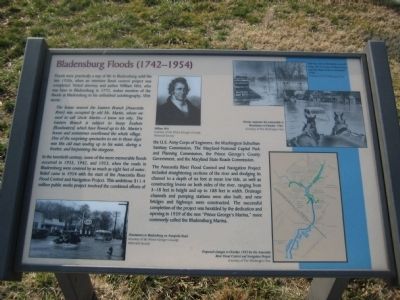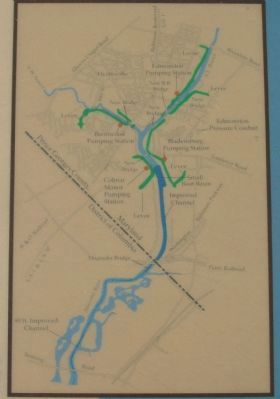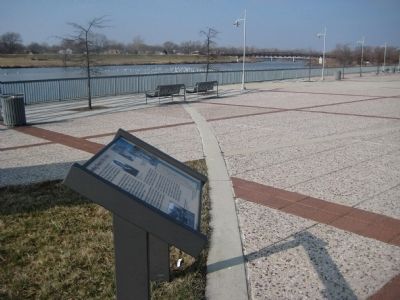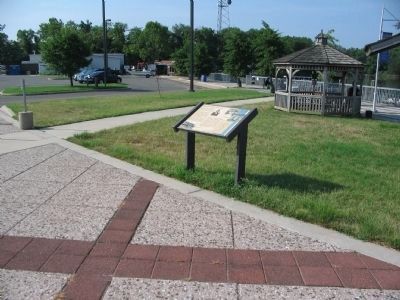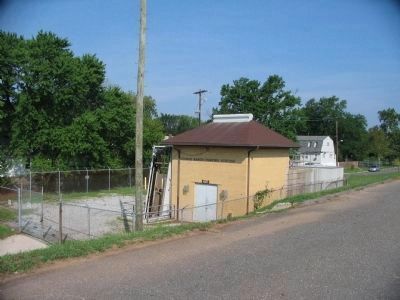Bladensburg in Prince George's County, Maryland — The American Northeast (Mid-Atlantic)
Bladensburg Floods (1742-1954)
The house nearest the Eastern Branch [Anacostia River] was occupied by old Mr. Martin - I know not why. The Eastern Branch is subject to heavy freshets [floodwaters], which have flowed up to Mr. Martin's house and sometimes overflowed the whole village. One of the surprising spectacles to me in those days was this old man wading up to his waist, during a freshet, and harpooning a sturgeon.
In the twentieth century, some of the more memorable floods occurred in 1933, 1942, and 1954, when the roads in Bladensburg were covered by as much as eight feet of water. Relief came in 1954 with the start of the Anacostia River Flood Control and Navigation Project. This ambitious $11.4 million public works project involved the combined efforts of the U.S. Army Corps of Engineers, the Washington Suburban Sanitary Commission, The Maryland-National Capital Park and Planning Commission, the Prince George's County Government, and the Maryland State Roads Commission.
The Anacostia River Flood Control and Navigation Project included straightening sections of the river and dredging its channel to a depth of six feet at mean low tide, as well as constructing levees on both sides of the river, ranging from 3-18 feet in height and up to 188 feet in width. Drainage channels and pumping stations were also built, and the new bridges and highways were constructed. The successful completion of the project was heralded by the dedication and opening in 1959 of the new "Prince George's Marina," more commonly called the Bladensburg Marina.
Text with lower-left photo: Floodwaters in Bladensburg on Annapolis Road
Text with upper-middle photo: William Wirt
Text with upper-right photo: With four feet of floodwater and still rising, this is an area of Bladensburg near the Peace Cross in November 1950.
Text with middle-right photo: Horses outpower the automobile in floodwaters of October 1942.
Text with lower-right photo: Proposed changes in October 1953 for the Anacostia River Flood Control and Navigation Project
Topics. This historical marker is listed in these topic lists: Arts, Letters, Music • Colonial Era • Industry & Commerce • Waterways & Vessels. A significant historical year for this entry is 1772.
Location. 38° 56.057′ N, 76° 56.304′ W. Marker is in Bladensburg, Maryland, in Prince George's County. Marker can be reached from the intersection of Annapolis Road (Maryland Route 450) and 46th Street. Marker is in Bladensburg Waterfront Park, .2 miles south of the entrance at this intersection. Touch for map. Marker is in this post office area: Bladensburg MD 20710, United States of America. Touch for directions.
Other nearby markers. At least 8 other markers are within walking distance of this marker. Clearing the Way to Washington (a few steps from this marker); Joshua Barney's Barge and the Chesapeake Flotilla (a few steps from this marker); The First Telegraph Line (1844) (within shouting distance of this marker); Colonial Ropemaking (within shouting distance of this marker); Railroad History in Bladensburg (about 300 feet away, measured in a direct line); Encampment of Coxey's Army (1894) (about 300 feet away); Dinosaur Alley (about 300 feet away); The Incidental Cause of the Star-Spangled Banner (1814) (about 400 feet away). Touch for a list and map of all markers in Bladensburg.
Credits. This page was last revised on January 12, 2020. It was originally submitted on June 8, 2008, by F. Robby of Baltimore, Maryland. This page has been viewed 2,384 times since then and 35 times this year. Photos: 1. submitted on June 8, 2008, by F. Robby of Baltimore, Maryland. 2. submitted on July 18, 2010, by Craig Swain of Leesburg, Virginia. 3. submitted on June 8, 2008, by F. Robby of Baltimore, Maryland. 4, 5. submitted on July 18, 2010, by Craig Swain of Leesburg, Virginia.
